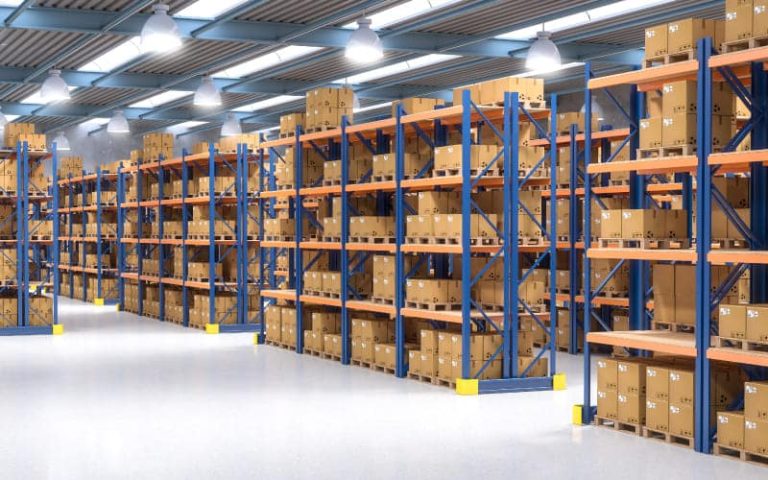It’s the stuff of nightmares for warehouse operators. You’ve bought your pallet racks, sketched out a warehouse floor plan, and you have installers ready to go…and your permits are delayed. Or worse yet, they are rejected.
Meantime, you’re paying a crew that’s waiting around, and you’ve got to revise the plans. Who knows how long it’s going to take and how much it’s going to cost.
Not fun.
Sadly, it happens more often than you might think, and yes, it can be expensive. But it doesn’t have to be that way. With a solid warehouse setup project plan and engineer-stamped drawings, you can rest easy knowing that you can streamline the permitting and inspection process and get your warehouse up to speed faster.
Let’s dig into efficient warehouse planning and answer the questions you may have about the importance of a Professional Engineering stamp, when stamped plans are required, and how to get your construction plans reviewed and sealed.
Efficient Warehouse Planning
Successful warehouse projects begin with comprehensive planning that anticipates regulatory requirements. This proactive approach starts with aligning your operational objectives with physical design.
Understanding throughput requirements, inventory profiles, material handling systems, and staffing models provides the foundation for technical specifications that will eventually require permitting and engineering approval.
Involving key stakeholders early is essential for efficient planning. This should include operations, facilities teams, compliance officers, fire protection specialists, and experts familiar with local building codes. Early consultation with engineering professionals who will ultimately provide stamped drawings can prevent significant redesign work later.
These timelines should account for typical review periods in your jurisdiction—which can range from weeks to months—as well as contingency time for addressing comments and revisions. The most successful projects treat permitting not as an afterthought but as a critical-path item that deserves detailed scheduling.
Most jurisdictions offer pre-meetings to discuss proposed projects before formal submission. These meetings provide opportunities to identify potential compliance issues, understand reviewer expectations, and establish working relationships with the key personnel who will be evaluating your plans.
Designing Your Warehouse Floor Plan
Beyond compliance and permitting, however, your warehouse setup project plan needs to meet a few key objectives. Safety is at the top of the list, so your plan needs to ensure proper zoning, clear pathways, and safety features to avoid hazards.
You also want to maximize your storage capacity, especially your vertical space and storage density. This provides you with greater capacity in a smaller space.
Your warehouse floor plan needs to create efficiencies. For example, if you are a fulfillment center, travel time for pickers can account for more than half of your labor costs. So, an efficient workflow can reduce your costs. Creating an efficient throughput and implementing product slotting strategies can further reduce cycle times.
Likewise, the right material handling equipment and automation can make a significant difference in your productivity and efficiency.
What Permits Do You Need for a Warehouse?
While requirements vary by jurisdiction, several categories of permits are consistently required for warehouse development.
- Building permits certify that proposed structures comply with applicable building codes regarding structural integrity, fire safety, accessibility, energy efficiency, and occupant safety.
- Zoning permits ensure that proposed facilities comply with local land use regulations. Warehouses typically require industrial or commercial zoning designations, though some jurisdictions have created classifications for distribution facilities.
- Environmental permits address potential impacts on natural resources and surrounding communities.
- Fire safety permits merit special attention for warehouse facilities, which present unique challenges due to high rack storage, potentially combustible inventory, and large undivided floor areas.
Specialized warehouses trigger additional permit requirements, based on their functions.
Cold storage facilities must address refrigeration systems, insulation requirements, and often specialized foundations. Hazardous materials warehouses require compliance with chemical storage regulations, secondary containment provisions, and emergency response planning. Food-grade warehouses must meet FDA or USDA standards, while pharmaceutical storage may need to comply with controlled substance regulations.
The Importance of a PE Stamp
Professional Engineer (PE) certification represents one of the most significant quality assurance components in warehouse development. What are stamped plans? They are the documentation that details your warehouse project plan and demonstrates it’s been thoroughly reviewed by a professional engineer.
A PE stamp indicates that an engineer has validated the accuracy and code compliance of specific design elements. This certification provides legal verification that plans meet established engineering standards and building code requirements.
Engineer-stamped drawings can streamline regulatory compliance by providing building officials with assurance that technical elements have been designed by qualified professionals. This often streamlines the review process, as code officials can focus their attention on compliance issues rather than conduct comprehensive engineering analyses. Many jurisdictions have implemented expedited review processes for professionally stamped drawings.
Engineers experienced in warehouse design can also identify opportunities for efficiency, which extend beyond compliance, potentially suggesting alternatives that improve functionality while reducing costs.
What Are Stamped Plans?
Engineer-stamped drawings are the technical drawings and specifications that bear the seal and signature of a licensed professional engineer.
These documents typically include:
- Warehouse project plan drawings
- Warehouse floor plan
- Structural calculations
- Load capacity analysis
- Seismic considerations
- Foundation and anchoring specifications
Engineer-stamped drawings make sure your warehouse meets local and state building codes, applicable fire safety requirements, OSHA standards, and guidelines from the American National Standards Institute (ANSI) and the Rack Manufacturers Institute (RMI).
When Are Stamped Plans Required?
Size and scope thresholds that trigger PE stamp requirements vary by jurisdiction but are generally mandatory for commercial and industrial projects exceeding certain square footage thresholds. While small tenant improvements might proceed with minimal engineering involvement, warehouses—which typically feature large open spaces, high rack storage, and specialized equipment—almost invariably cross these thresholds.
In most areas, any commercial structure exceeding 5,000 square feet requires comprehensive engineering certification, with additional requirements for buildings with heights exceeding standard construction.
Occupancy classifications significantly impact stamping requirements for your warehouse project plan as well.
Warehouses typically fall under Factory/Industrial or Storage occupancy categories depending on whether they include processing activities or function purely as storage facilities. For example, high-piled storage arrangements—common in modern warehouses—often require enhanced fire protection specifications that need specialized engineering analysis.
Get Your Warehouse Construction Plans Reviewed
The warehouse setup project plan review process represents a critical quality control checkpoint that deserves careful attention and preparation. While specific procedures vary between jurisdictions, most follow a similar pattern: initial screening for completeness, technical review by specialists in each discipline, consolidation of comments, communication with applicants, and eventually, approval or requests for revisions.
Common reasons for warehouse setup project plan rejection include:
- Insufficient detail for reviewers to verify code compliance
- Inconsistencies between different drawing sets
- Missing calculations to support design decisions
- Failure to address specific amendments to standard building codes
Mistakes are costly and can cause significant delays. They can also increase design costs for rework or mitigation. That’s another reason you want to work with an engineer with expertise in warehouse design. You also want someone who will be available to respond to any questions about your warehouse project plan and help overcome any obstacles in the permitting process.
Get Your Warehouse Construction Plans Sealed
Properly sealed plans provide a permanent record of engineering decisions, create accountability for design professionals, and establish a standard against which construction can be measured. For warehouse operators, warehouse floor plans also provide valuable reference information for future modifications, equipment installations, or troubleshooting building systems.
The stamping process isn’t simply a matter of applying a seal to completed drawings, however. It represents a comprehensive engineering review.
Liability considerations also influence how engineers approach the stamping process.
Professional engineers maintain legal responsibility for designs bearing their seals, potentially extending for many years after project completion. This liability exposure explains why engineers carefully review all aspects of plans before applying their stamps and why they may sometimes require design modifications to address potential concerns.
Construction teams should always work from official sealed sets, with any field modifications properly documented and approved by the original engineer of record. Upon project completion, as-built drawings that incorporate construction-phase changes should be prepared and sealed, providing accurate documentation of the facility as actually constructed.
Put Conesco Storage Systems to Work for You
Professional permit preparation and engineer-stamped drawings aid in fast-tracking permitting and approval while creating the blueprint for safe and efficient warehouse project plans. When you partner with warehouse engineering experts like those at Conesco Storage Systems, you get everything you need to streamline permitting and build out a safe and efficient warehouse layout.
With your warehouse setup project plan in hand, you can accelerate timelines, ensure safety and compliance, and minimize the cost of mid-project changes. We work collaboratively with you to develop a warehouse setup project plan and build it out to your exact specifications.
Our engineer-stamped drawing process is methodical, ensuring that we capture your design requirements and provide the documentation you need to get permits approved. This typically includes:
- An initial consultation to discuss your project, timeline, and requirements
- Site assessment to gather data for accurate drawings
- Preliminary design based on your specifications and site requirements
- Review and refinement to meet your operating needs
- Final drawings and calculations for permitting submission
- Professional engineer-stamped drawings certifying compliance
- Support with permit submission and approval, including responding promptly to questions from local authorities.
Conesco is a full-service material handling company that can help you take your project from initial concept to operations. We can provide you with expert warehouse project plans, engineer-stamped drawings, help with the permitting process, expert labor for installations, and material handling equipment. We are one of the country’s largest warehouse equipment dealers and have a wide range of new and used warehouse equipment from top brands.
Frequently Asked Questions—FAQs About Warehouse Planning and Permitting
What are the most common reasons warehouse permits get rejected?
The most frequent rejection reasons include insufficient detail in drawings, inconsistencies between different drawing sets, missing structural calculations, and failure to address local amendments to standard building codes. Working with experienced engineers familiar with warehouse requirements significantly reduces your rejection risk.
Do I need engineer-stamped drawings for all warehouse modifications?
Minor changes might not require stamped drawings, but most jurisdictions require professional engineering certification for modifications that affect structural integrity, fire safety systems, or changes to occupancy classification. It’s always best to check with local authorities beforehand.
How much does it cost to get professional engineer-stamped drawings?
Engineering costs vary based on project complexity, warehouse size, and specific requirements. While material handling equipment represent an upfront investment, they typically save significant money by preventing delays, redesigns, or mistakes.
Can I use the same warehouse floor plan design across different locations?
While core design principles may transfer across locations, each jurisdiction has its own building codes and zoning requirements. Additionally, site-specific factors and local fire protection requirements likely require customization.
What information should I prepare before meeting with an engineer about my warehouse project plan?
Come prepared with information about your operational needs (throughput requirements, inventory profiles, material handling systems, site details, budget constraints, and timeline expectations. The more specific information you can provide, the more tailored and efficient the engineering process will be.
When you need efficient warehouse planning, expert advice, and engineer-stamped documents, call the warehouse experts at Conesco Storage Systems at (303) 690-9591 or contact us online to request a free consultation.



